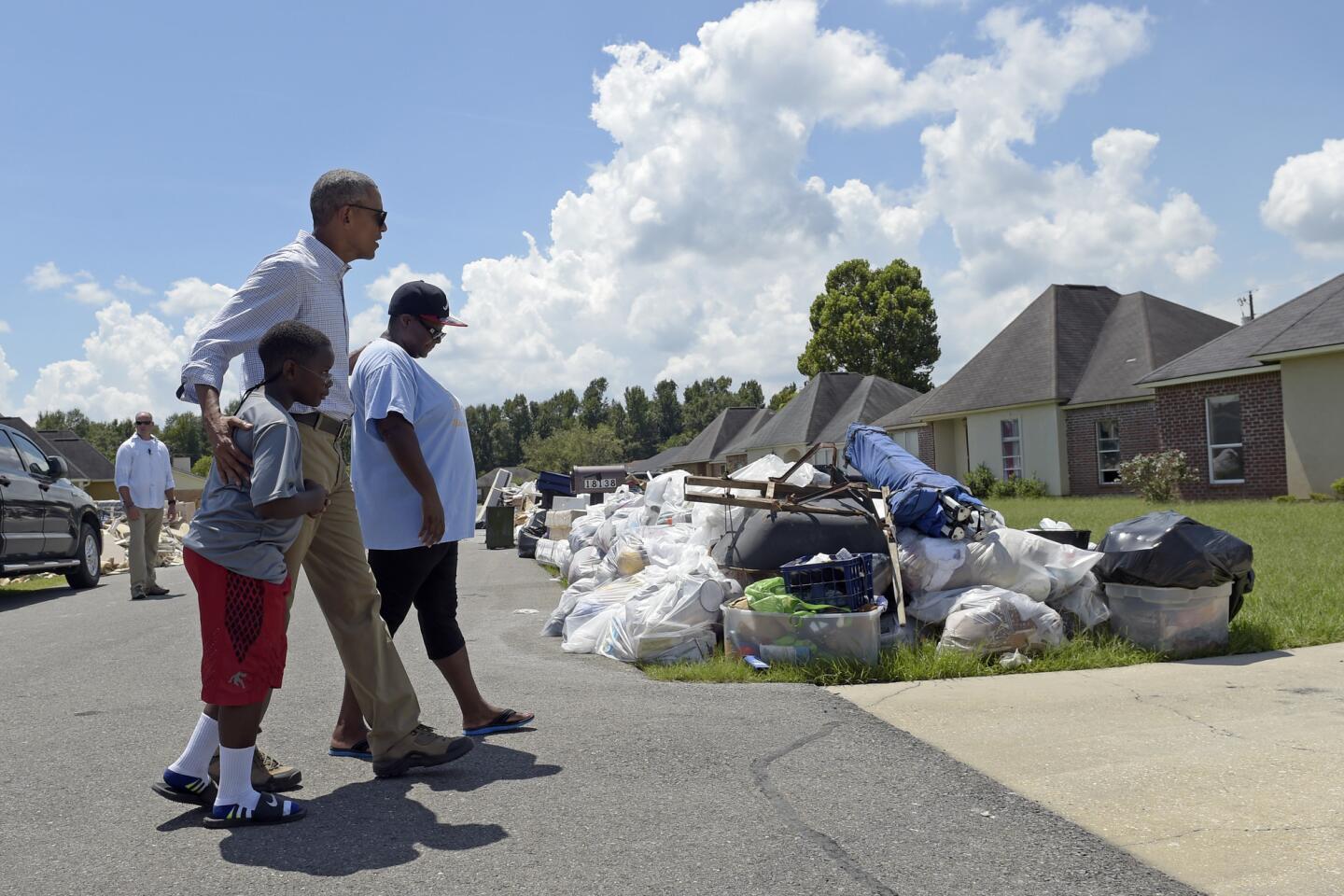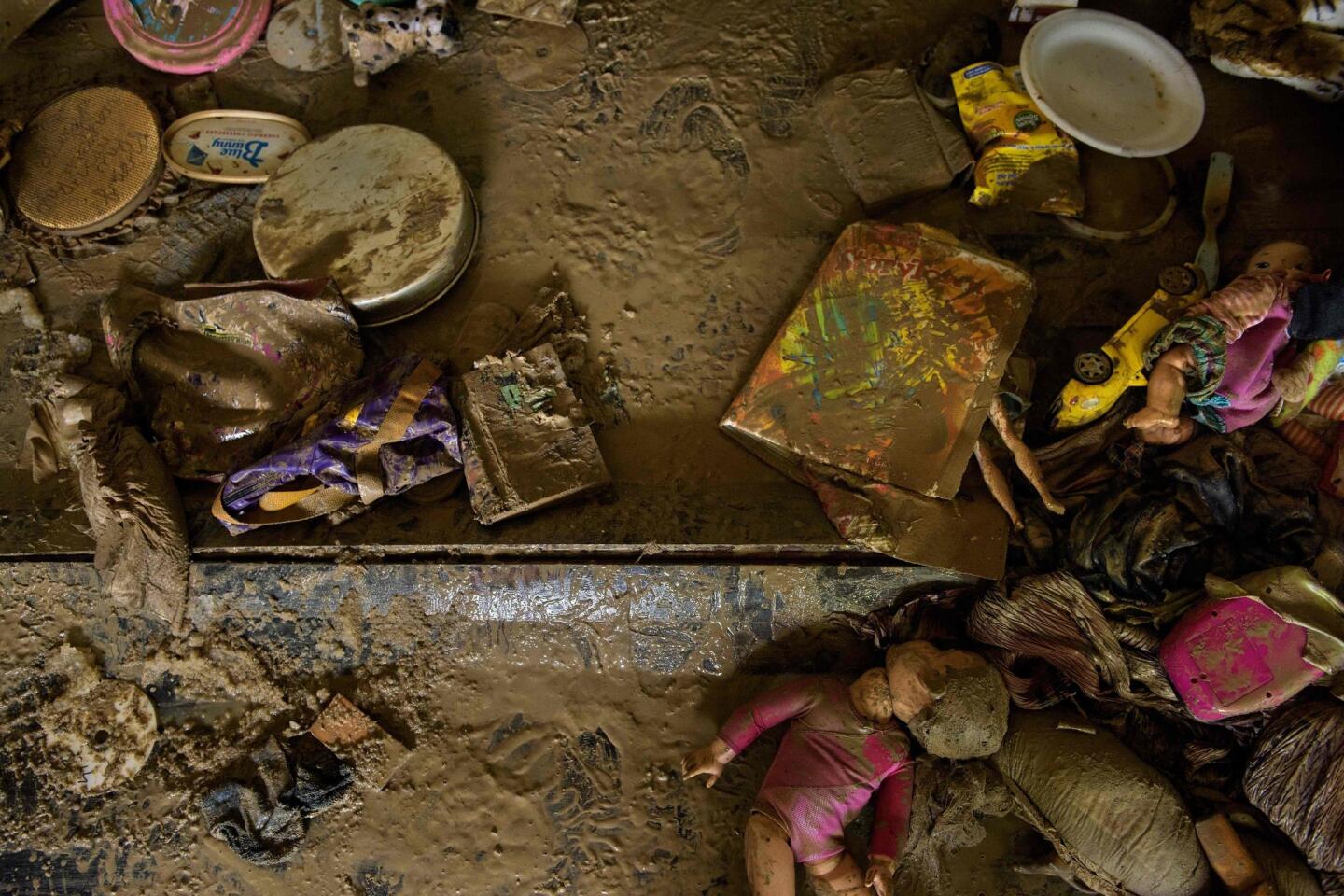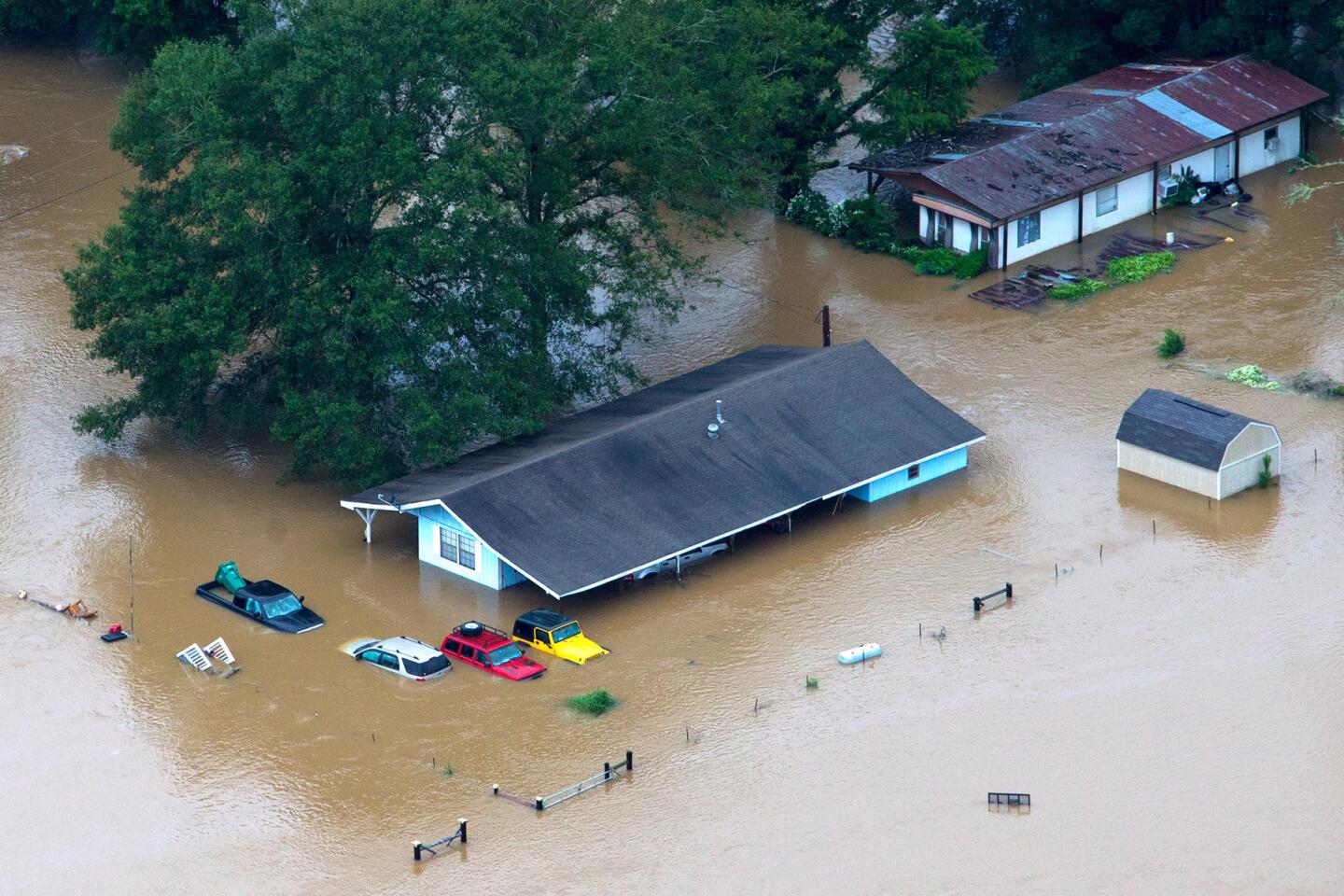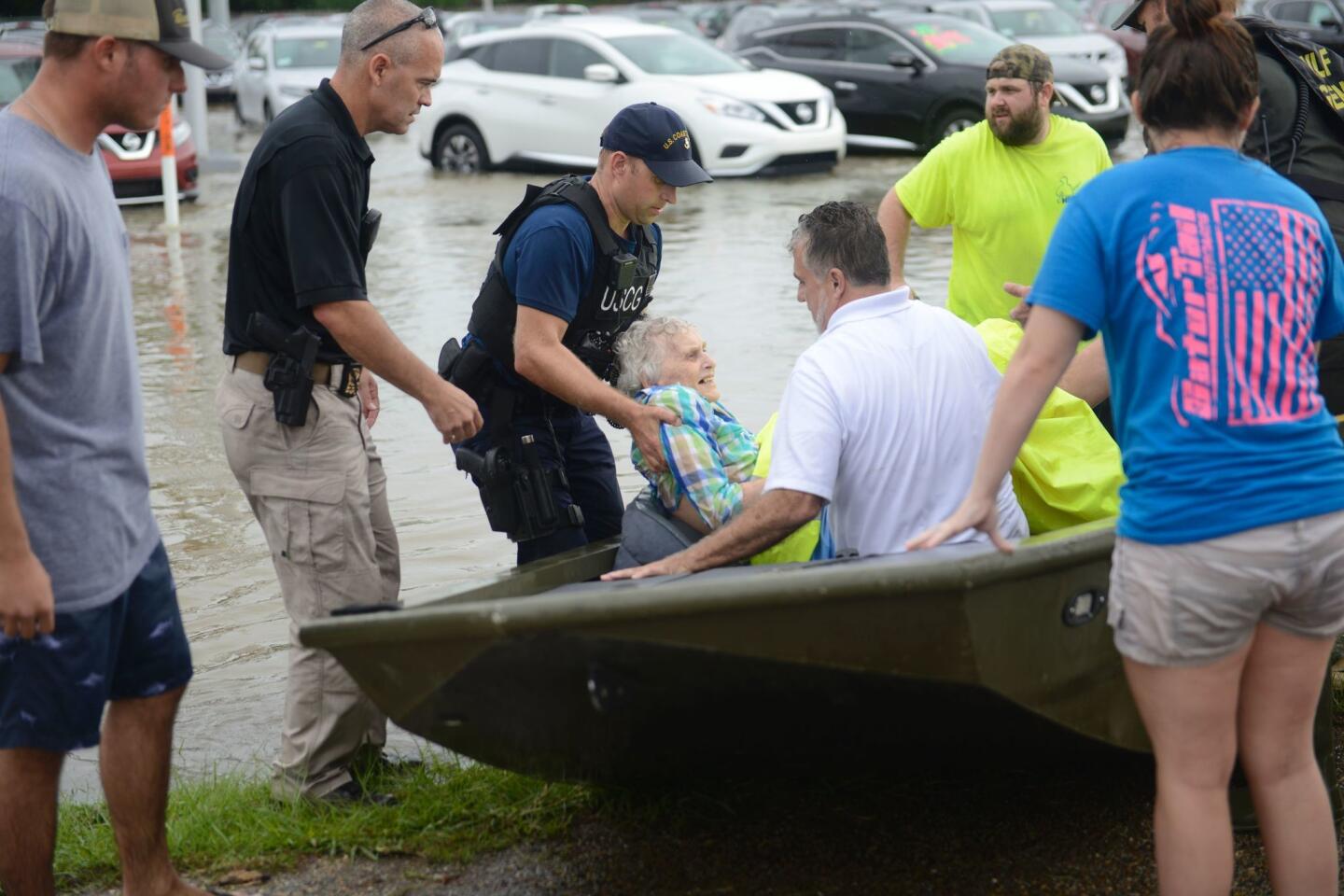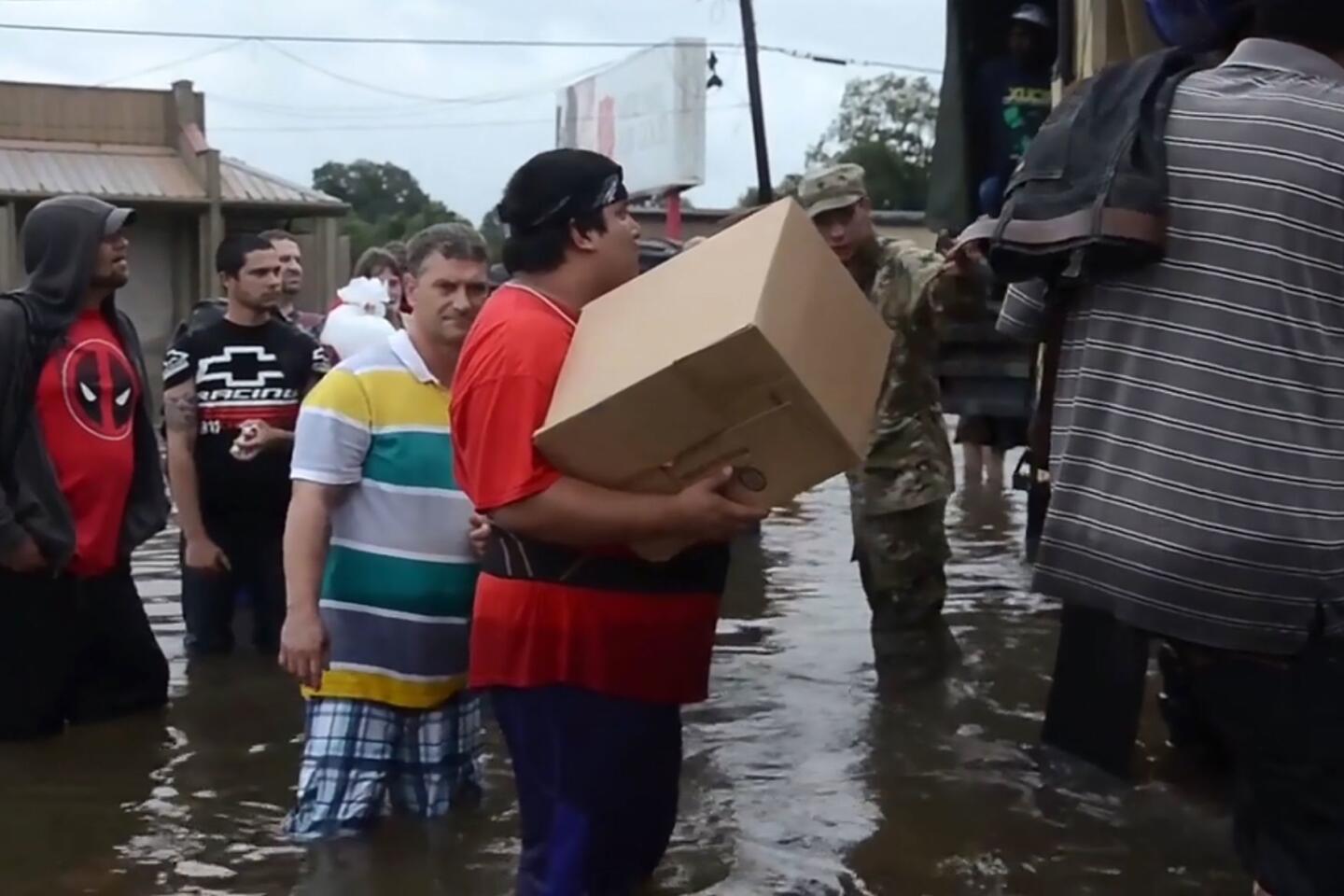‘Like nothing we’ve ever seen’: Flood danger is not over in Louisiana
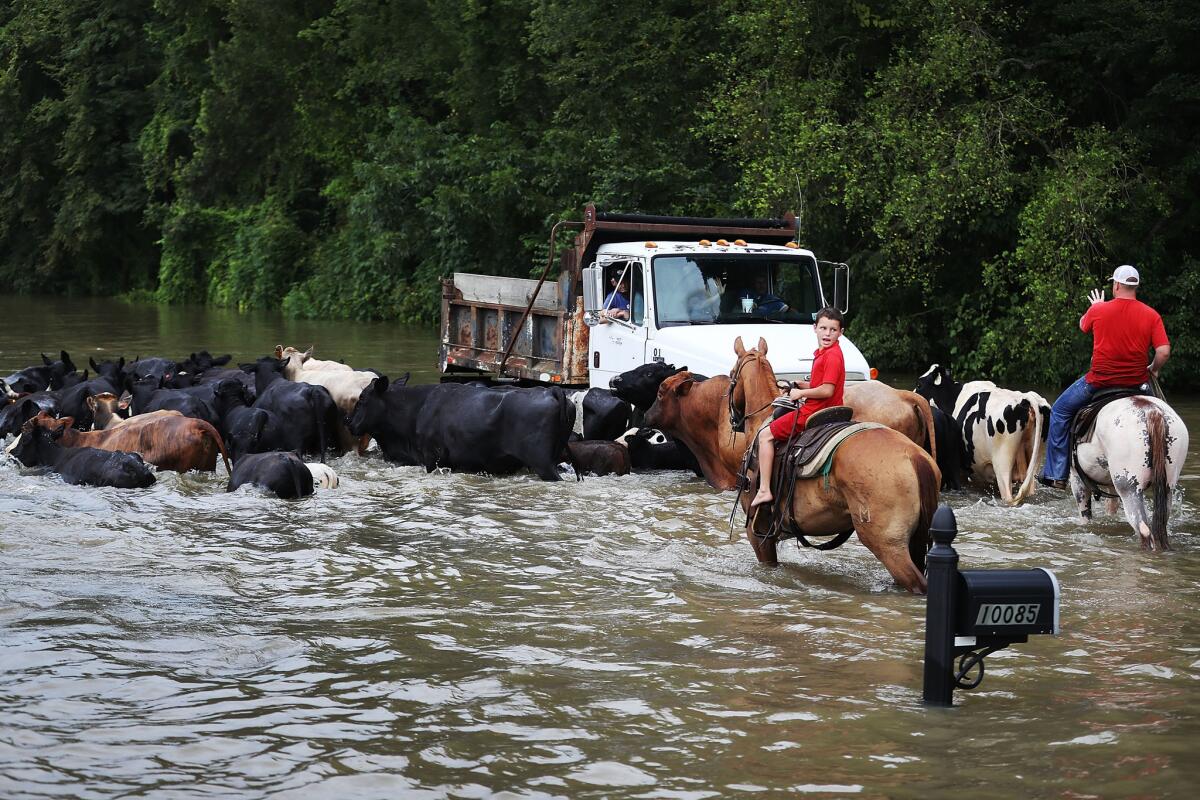
- Share via
Reporting from Atlanta — Slowly, residents began to return to water-ravaged homes in Baton Rouge on Tuesday after heavy rain submerged large stretches of southern Louisiana, killing 11 people, damaging entire neighborhoods and prompting tens of thousands of rescues.
Yet as floodwater flowed downstream, officials warned that the danger was far from over. In communities to the south — still in rescue mode — residents were urged to stay in their homes or evacuate.
The devastation was severe. In Livingston Parish, just east of Baton Rouge, officials estimated that as many as 75% of the area’s 52,000 homes had been damaged by floodwaters. Southeast, in Ascension Parish, water had seeped into one of every three homes.
“We’ve been through Hurricane Gustav, Katrina, Isaac and Rita, but this without a doubt is the roughest we’ve ever had in this parish,” said Livingston Parish Sheriff Jason Ard.

By Tuesday morning, more than 40,000 people across Louisiana had registered for federal emergency aid. Here’s a look at the effects of Louisiana’s flooding by the numbers.
As many as 20,000 of the parish’s 141,000 residents had to be rescued after the area endured 25 inches of rain in just three days, Ard said. About 5,000 residents were in shelters.
“At least 75 of my deputies no longer have a home,” Ard said. “What do you tell them? It’s heartbreaking to see a man have an emotional moment, wipe his tears away, and then get back on his boat and take off. He knows his people need him.”
Sheriff’s Sgt. Gene Higginbotham continued to work 12-hour shifts at the local Emergency Operations Center in Livingson Parish, helping with rescue efforts as his own home was engulfed in almost knee-deep water.
On Saturday, the 42-year-old was injured when his police SUV was overtaken by flood water as he tried to move his wife, daughter and mother out of their one-story brick home. After visiting a local emergency room to get stitches on his arm, he was soon back at work, coordinating shelters at local schools and churches.
“It’s not easy,” he said of staying at his in-laws’ place and leaving his wife to venture back home to rip up baseboards.
“You know you’re feeling lost, but you just have to try to put some of that stuff in the back of mind when you’re at work,” he said. “It’s just one of those things. You worry about your family, and you worry about your home. At same time, you’ve got a job to do. You kind of carry on.”
Some of his colleagues, he said, had as much four to six feet of water in their homes. “It’s total destruction, and they were back at work, putting their gear on and rescuing people,” he said. “Our sheriff, he told us: ‘We’re going to get through this.’”
On Tuesday, President Obama expanded the federal disaster declaration for Louisiana to 20 parishes. More than 60,000 people across the state had already registered for federal aid.
“This is a historic flooding event,” Gov. John Bel Edwards said Tuesday. “When you have a storm that is unnamed — it wasn’t a tropical storm, it wasn’t a hurricane — a lot of times people underestimate the impact that it would have.… But this is historic. We are seeing unprecedented flood levels as the waters move south.”
Edwards estimated that more than 40,000 homes had been damaged by the heavy rainfall and floodwater. About 8,000 people were taking refuge in shelters, he said, noting that the number is shifting as residents return home, relocate with family or move into motels.
With sporadic looting, dawn-to-dusk curfews and more than 30,000 homes and businesses without power, it was clear the disaster was not over.
“I want everyone to understand: Nobody has been forgotten,” Edwards said.
In many of the worst-hit parishes, emergency teams began to coordinate door-to-door search and rescue operations, checking and marking homes as well as cars that had washed off the roads.
Dana Richardson of Gonzalez, who has been staying in a hotel since Friday night, said local stores were running out of food, and she wasn’t sure when they would receive more shipments.
“There isn’t bread for miles!” she said.
Yet people were cooking huge pots of jambalaya and passing out servings. Local residents from Baton Rouge and Zachary cooked large batches of red beans to feed sheriffs in Ascension Parish. Restaurant owners from New Orleans drove more than 50 miles to flooded areas to serve chicken fricassee, cornbread and bread pudding.
“Even through disaster, God has shown us how strong love truly is,” Richardson said. “There is no end to the kindness that our people have right now. Our community is saving each other.”
Nearly 15,000 homes in Ascension Parish were flooded, said Richard Webre, director of the parish’s Office of Homeland Security and Emergency Preparedness. Residents who lived in low-lying areas near waterways were urged to evacuate Monday night after water breached a 14.5-foot levee along the Amite River.
As the scope of the devastation sunk in, many Louisiana residents took to social media to rail against news outlets for what they believed was their lack of coverage. Why, some wondered, was the displacement of thousands of people less deserving of attention than the Olympics or Donald Trump?
“How the #laflood is not on national news truly amazes me,” Abigail Mawae of Baton Rouge posted on Twitter.
“Why isn’t national media covering the floods in Louisiana?” tweeted Amy Crowe Duhe, a Baton Rouge nursing student. “This is like nothing we’ve ever seen before.”
Craig Fugate, administrator of the Federal Emergency Management Agency, assured Louisianans his agency was committed to supporting a full recovery across the state — whether or not the natural disaster was commanding front-page national media attention.
“You have the Olympics, you got the election,” he said. “If you look at the national news, you’re probably on the third or fourth page. FEMA understands this is a very large disaster impacting tens of thousands of people. Regardless of what it may be getting in the national coverage, we know there has been a significant impact here in Louisiana.”
The Louisiana flooding is likely the worst natural disaster in the United States since Superstorm Sandy hammered the East Coast in 2012, according to the Red Cross.
Harrowing rescues were posted on social media as emergency teams continued to evacuate residents in East Baton Rouge, Livingston and Ascension parishes. The East Baton Rouge Sheriff’s Office shared footage taken from a helicopter Monday of rescuers saving a man from waist-high floodwater and two others clinging to a tree.
On Tuesday, floodwater inundated the small town of Sorrento in Ascension Parish, the parish sheriff’s office reported. With several inland waterways unable to drain into their usual channels, Meredith Conger, planning and intelligence officer at Ascension Parish Homeland Security, warned residents living near low-lying areas around Bayou Narcisse, Bayou Francois, New River Canal and Black Bayou that they remained at risk.
“We are not out of danger yet,” Conger said in a video statement. “If you feel threatened and you have the capability of getting out of your homes and to safety — you are encouraged to voluntarily evacuate.”
As of Tuesday evening, local and state officials had reported that 11 people had died as a result of flooding — five in East Baton Rouge Parish, three in Tangipahoa Parish, two in St. Helena Parish and one in Rapides Parish.
Many residents whose homes were damaged by the floods were not covered by national flood insurance, said Rafael Lemaitre, a FEMA public information officer. Just over 20% of Louisiana residences carry flood insurance, and that number is lower in many of the parishes most afflicted by the rainstorms.
Jarvie is a special correspondent. Times staff writer Molly Hennessy-Fiske contributed reporting.
ALSO
Man accused of killing Oklahoma neighbor has criminal record in Southern California
10 years after joining Obama’s team, these ‘lifers’ are getting ready to leave the White House
What Donald Trump means when he proposes ‘extreme vetting’ for would-be immigrants
UPDATES:
Aug. 17, 8:20 a.m.: This article was updated with additional comments from people affected by the flooding.
This article was originally published Aug. 16 at 8:05 p.m.
More to Read
Sign up for Essential California
The most important California stories and recommendations in your inbox every morning.
You may occasionally receive promotional content from the Los Angeles Times.


